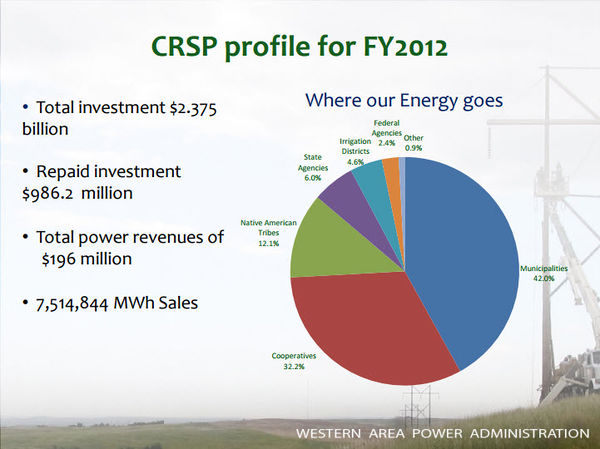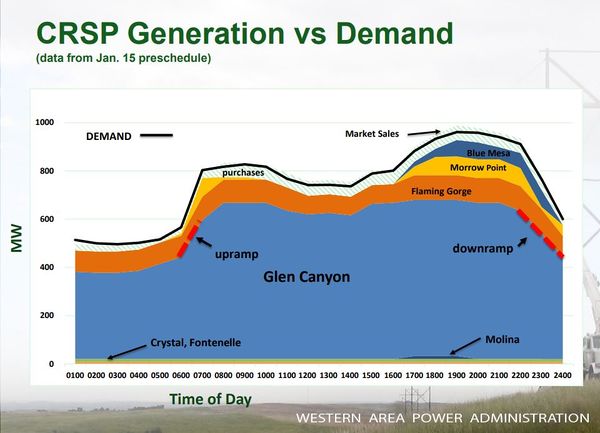Difference between revisions of "HYDROPOWER"
Cellsworth (Talk | contribs) |
Cellsworth (Talk | contribs) |
||
| Line 68: | Line 68: | ||
|style="color:#000;"| | |style="color:#000;"| | ||
| − | WAPA's Colorado River Storage Project (CRSP) is one of five regions. Our main offices include a Headquarters office in Lakewood, Colorado; regional offices in Billings, Montana; Loveland, Colorado; Phoenix, Arizona; and Folsom, California | + | WAPA's Colorado River Storage Project (CRSP) is one of five of its regions. Our main offices include a Headquarters office in Lakewood, Colorado; regional offices in Salt Lake City, Utah; Billings, Montana; Loveland, Colorado; Phoenix, Arizona; and Folsom, California. CRSP's Energy Management and Marketing Office (EMMO) is located in Montrose, Colorado. |
| + | |||
| + | The CRSP Region carries out WAPA’s mission in Arizona, Utah, Colorado, New Mexico, Nevada, Wyoming and Texas. We sell about 5,300 gigawatthours to cities and towns, rural electric cooperatives, Native American tribes, irrigation districts and federal and state agencies. This is enough energy to provide electric power for a year to 1.2 million homes. | ||
CRSP markets power from the Colorado River Storage Project, its participating projects (Dolores and Seedskadee) and the Collbran and Rio Grande projects. These resources comprise 11 powerplants located in Arizona, Colorado, New Mexico, Utah and Wyoming and are marketed together as the Salt Lake City Area/Integrated Projects. We also market power from the Provo River Project and Olmsted Project in Utah; and the Falcon-Amistad Project in Texas. Transmission service is provided by transmission facilities in Arizona, Colorado, Nevada, New Mexico, Utah and Wyoming either owned or leased by WAPA. | CRSP markets power from the Colorado River Storage Project, its participating projects (Dolores and Seedskadee) and the Collbran and Rio Grande projects. These resources comprise 11 powerplants located in Arizona, Colorado, New Mexico, Utah and Wyoming and are marketed together as the Salt Lake City Area/Integrated Projects. We also market power from the Provo River Project and Olmsted Project in Utah; and the Falcon-Amistad Project in Texas. Transmission service is provided by transmission facilities in Arizona, Colorado, Nevada, New Mexico, Utah and Wyoming either owned or leased by WAPA. | ||
Revision as of 12:11, 4 September 2024
|
|
The Hydropower ResourceGlen Canyon Dam is the second highest (710 feet) concrete-arch dam in the United States, second only to Hoover Dam which stands at 726 feet. The 26.2 million acre-feet of water storage capacity in Lake Powell, created by Glen Canyon Dam, serves as a ‘bank account’ of water that is drawn on in times of drought. This stored water has made it possible to successfully weather extended dry periods by sustaining the needs of cities, industries, and agriculture throughout the West. Hydroelectric power produced by the dam’s eight generators helps meet the electrical needs of the West’s rapidly growing population. With a total capacity of 1,320 megawatts, Glen Canyon Powerplant produces around five billion kilowatt-hours of hydroelectric power annually which is distributed by the Western Area Power Administration to Wyoming, Utah, Colorado, New Mexico, Arizona, Nevada, and Nebraska. In addition, revenues from production of hydropower help fund many important environmental programs associated with Glen and Grand canyons. The designation of Glen Canyon National Recreation Area in 1972, underscores the value and importance of the recreation benefits associated with Lake Powell and the Colorado River downstream of the dam. The GCNRA is managed by the National Park Service. Glen Canyon Dam is the key water storage unit of the Colorado River Storage Project, one of the most complex and extensive river resource developments in the world. Without it, development of the Upper Colorado River Basin states’ portion of the Colorado River would not have been possible. [1] LTEMP Resource Goal for the Hydropower ResourceMaintain or increase Glen Canyon Dam electric energy generation, load following capability, and ramp rate capability, and minimize emissions and costs to the greatest extent practicable, consistent with improvement and long-term sustainability of downstream resources. Desired Future Condition for the Hydropower Resource• Glen Canyon Dam capacity and energy generation is maintained and increased, so as to produce the greatest practicable amount of power and energy, consistent with the other DFCs. |
| --- |
Hydropower - Online Training |
--- |
|---|
|






